As readers of PropTalk know, the Chesapeake Bay offers some of the best cruising grounds in the world. My wife, my cat, and I have traveled by boat on the Intracoastal Waterway (ICW) and by trailering our Ranger Tugs 31CB, Scout. In this first of two articles, I will discuss the selection of our boat, trailer, and truck; logistics and permitting; and launching and retrieval of the boat. I will cover our trips and favorite stops in the next installment.
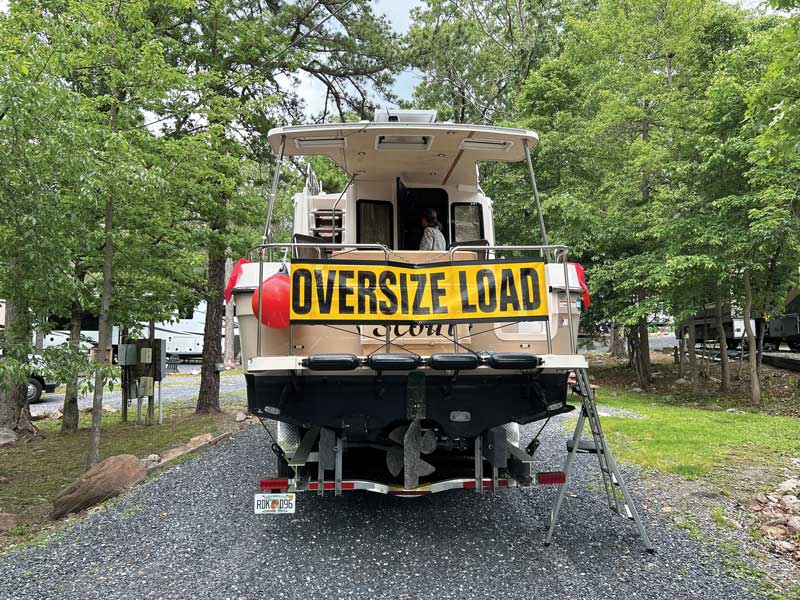
We have owned sailboats ranging from 28 to 36 feet, powerboats from 24 to 47 feet, and have cruised in Maine, Florida, the Great Lakes, Canada, California, Mexico, and throughout the East Coast of the US over the past 30 years. Like many sailors later in life, we have settled on a trawler lifestyle and found that trailering our 31-foot boat has opened up more cruising grounds than ever before. Trailering our Rosborough 246 was a breeze, but we found that a 24-foot boat didn’t offer the amenities we had grown accustomed to on larger boats, so we upgraded to our Ranger Tugs 31.
Permits and Monitoring
Upgrading from trailering an eight-foot, six-inches wide boat to a 10-foot-wide boat means wide load permits are now required for every state you travel through. While it’s possible to save money by doing it yourself for each state, you might save some trouble by using one of the services like Mercury Permits. I’ve used their services and also applied for permits myself, but some state permitting systems are cumbersome, so I prefer their services. Mercury Permits offers BoatUS members a discounted rate of $17.50 per permit in addition to each state’s permit cost, which ranges from $6 to $60.
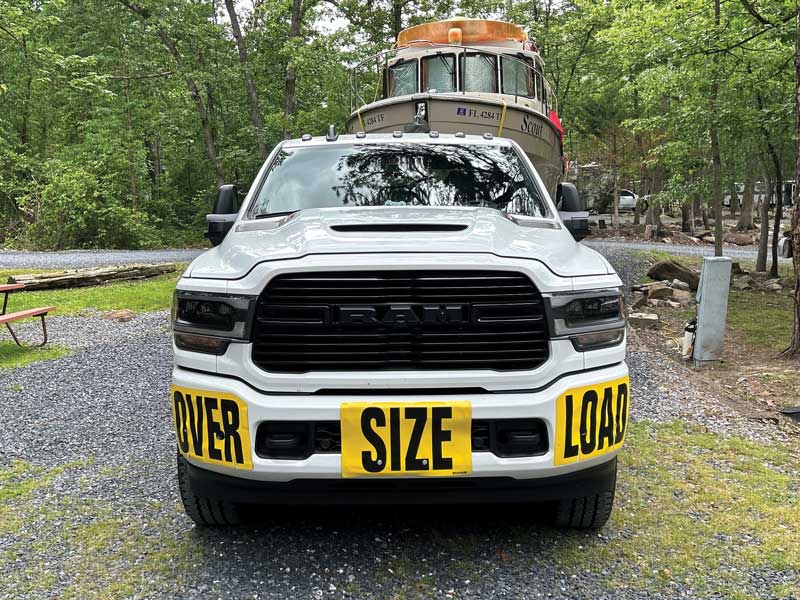
Trailering a wide load requires a few changes from trailering smaller boats that are the legal limit of eight feet, six inches. We are required to have a “wide load” banner on the front of the truck and on back of the load, as well as flags on the widest point of the load, so I attach the flags on the front and rear cleats of the boat. I attach a “wide load” banner on the back of the boat’s stern pulpit with bungee cords, but I wanted to avoid scratching the truck’s painted front bumper, so I use a magnetic “wide load” banner along with double sided tape. Some states also require the use of a revolving yellow light atop the truck, so I use one that simply plugs into my 12-volt outlet on the truck, run the cord out the back side window, and roll the window up.
I have found that a wireless camera mounted on the rear of the boat helps immensely in traffic to safely change lanes, placing the monitor on my dash so that I can glance at it while driving. Some vehicles have integral wireless rear camera capability, but my Ram does not, so I purchased a wireless camera and monitor. The distance from the camera to the monitor poses no problem with reception. I also use a tire pressure monitoring system that gives me a readout of my six trailer tire pressures and temperature underway. The tire pressure monitoring system has a booster for the signal that is strapped on the trailer tongue and plugged into 12-volt power in the bed of my truck, and the connection can easily be removed when the trailer is disconnected from the truck. The tire pressure monitoring system gave me an early warning when I blew out a trailer tire on I-95 in Georgia and allowed me to safely come to a stop alongside the road. Having an auto or boat policy that includes tire changing services is well worth the relatively low cost and saved me from having to change it myself with vehicles racing by on the side of the road.
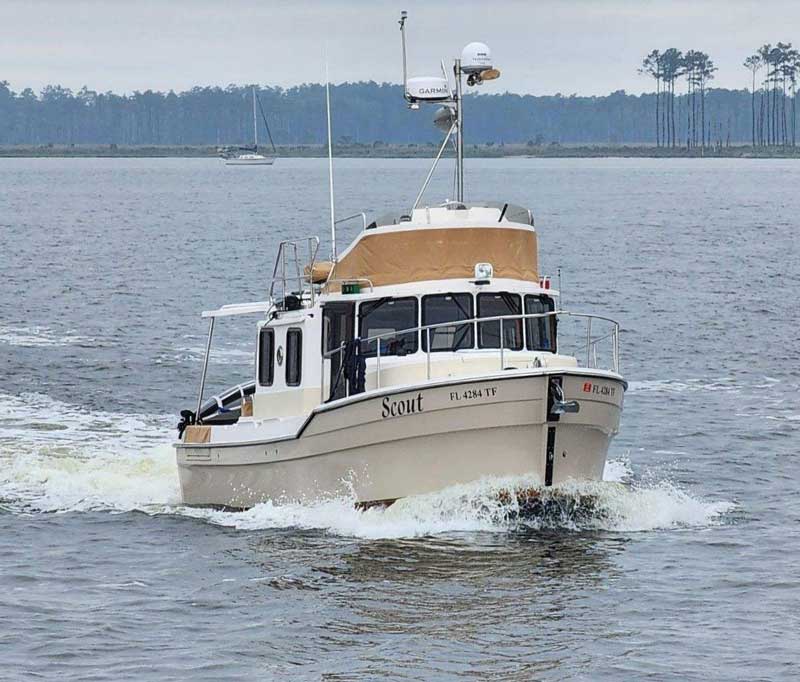
Selecting a Truck and Trailer
One of the more challenging aspects of trailering a larger boat is the added weight of the boat and trailer and sizing the truck properly. I wanted to stay below a 26,000 pound Gross Vehicle Weight Rating (GVWR) of the truck and trailer combined in order to avoid the hassle and cost of obtaining a commercial driver’s license (CDL), so after much research I sourced a new Ram 2500 truck and new Float On trailer. The truck has a GVWR of 10,000 pounds and the trailer has a GVWR of 15,000 pounds for a combined GWVR of 25,000 pounds, so I don’t need a CDL.
My boat and trailer combined weigh 14,300 pounds with 90 gallons of diesel, a full tank of water, and personal belongings. My truck weighs 9800 pounds with occupants and personal belongings and boat stuff in the bed. The truck is rated for a 10,000 load and to haul 20,000 pounds on a hitch tow, and the trailer is manufactured to handle much more weight than the 15,000-pound weight rating on the tag attached to the trailer. All this adds up to us not having to obtain a CDL, staying within the allowed weight loads as prescribed by the trailer and truck manufacturers, and being able to tow the load safely. After having my paperwork and loads checked by a state highway patrol officer and having to stop at some weigh stations, I was happy I took the time and effort to have the proper truck and trailer for our boat and obtain the wide load state permits.
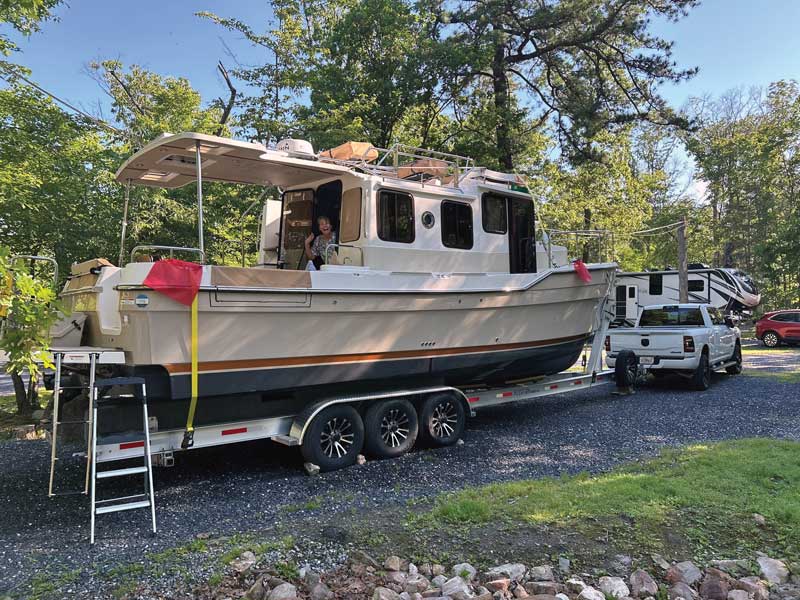
My trailer has electric over hydraulic brakes, and I selected the highest braking option available on my truck towing mode. The Ram 2500 has an engine braking system with similar effects as semi-truck exhaust braking systems and engine retarders such as a Jake Brake. Other than increased stopping distance and slower starts from a dead stop, the truck feels like it handles the same as when I’m not loaded down with the boat and trailer. I have noticed that other drivers give me a wider berth when they see the “wide load” banners as compared to my towing the smaller 24-foot boat. It’s not as white-knuckle driving as you would expect, but we travel less than 300 miles each day and pick our timing and routes to avoid traffic whenever possible.
Launching and Overnights
Launching and retrieving our Rosborough 246 at boat ramps was relatively easy compared to the Ranger Tugs 31CB. The added weight and width of a 31-foot boat as compared to a 24-foot boat makes it difficult to find boat ramps wide enough and with enough traction and slope to feel comfortable, so we have elected to use Travelifts. We are quite pleased with the services of Seven Seas Marina in Chester, MD, and storing our truck and trailer onsite and getting a power wash after the cruise is a plus.
We drove on interstates for the most part during our travels from Florida to Maine, but stopping in Chester, MD, to launch the boat required some travel on side roads. Obtaining wide load permits assures us of avoiding bridges less than the 13 feet, six inches minimum found on interstate highways in the U.S. Our boat is 13 feet, two inches high on the trailer, so we pay special attention to our routing, even using Google Maps to scout out potential obstacles along the way. Stopping at truck stops for fuel avoids the embarrassing situation of not having enough maneuvering room for our 60 feet in overall length.
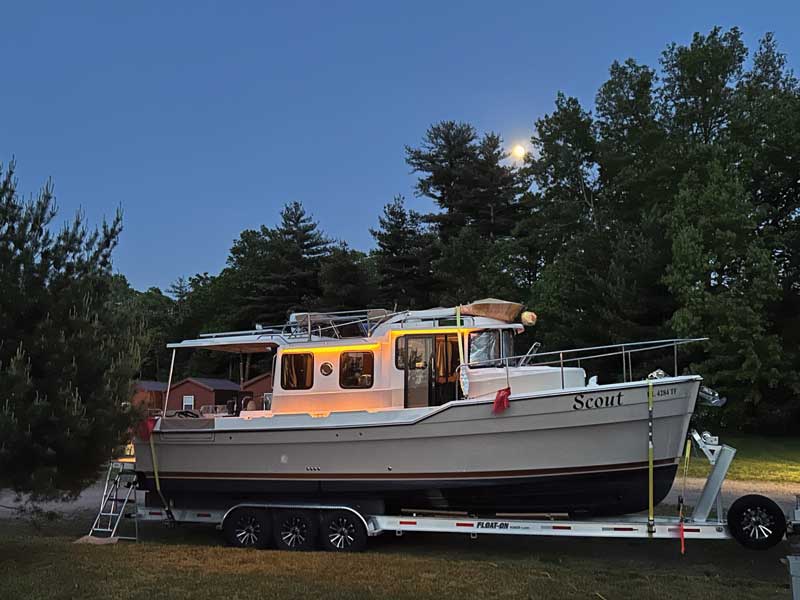
We use our boat as a travel trailer and stay aboard in KOA campgrounds and state parks and found most of them are accommodating. We let them know in advance that we are towing a boat on a 38-foot trailer. We capture our grey and black water just like an RV and utilize 120-volt campground power using adaptors and extension cords to keep our refrigerator and freezer topped off. While we can’t use our heating and cooling system because we’re not in the water, we have used portable AC and heating units at times but found them unnecessary if we travel in the spring and fall when temperatures are moderate. We request level pull-through big rig slots, so we don’t have to unhook or level our rig. The fun part is hearing the comments and getting stares at campgrounds. People say that they have never seen a boat used as a travel trailer but that it’s a great idea, and one asked if we “also put that thing in the water?” Many just stop and stare, some take pictures, and we chat while relaxing in our zero gravity chairs in the cockpit. Frankly, we don’t know why others haven’t found this lifestyle hack yet, but it works for us.
My next article will focus on our travels in the Chesapeake Bay including our favorite stops and anchorages, both trailering and traveling on the ICW.
About the author: Tim Smale and his wife Jennifer started sailing on a Newport 28 sloop on Lake Erie and a Cape Dory 36 ketch in the Great Lakes and on the West Coast from San Francisco to Mexico, where they spent two years cruising. They moved up to a Sealine 47 and cruised the Great Lakes and Canadian North Channel, then downsized to a Rosborough 246 and trailered between Florida and Maine. They found that trailering is the best of all worlds and, with their Ranger Tugs 31CB Scout, travel back and forth from Florida to Maine, stopping along the way to enjoy the Chesapeake Bay, and cruising Florida in the winter and New England in the summer.